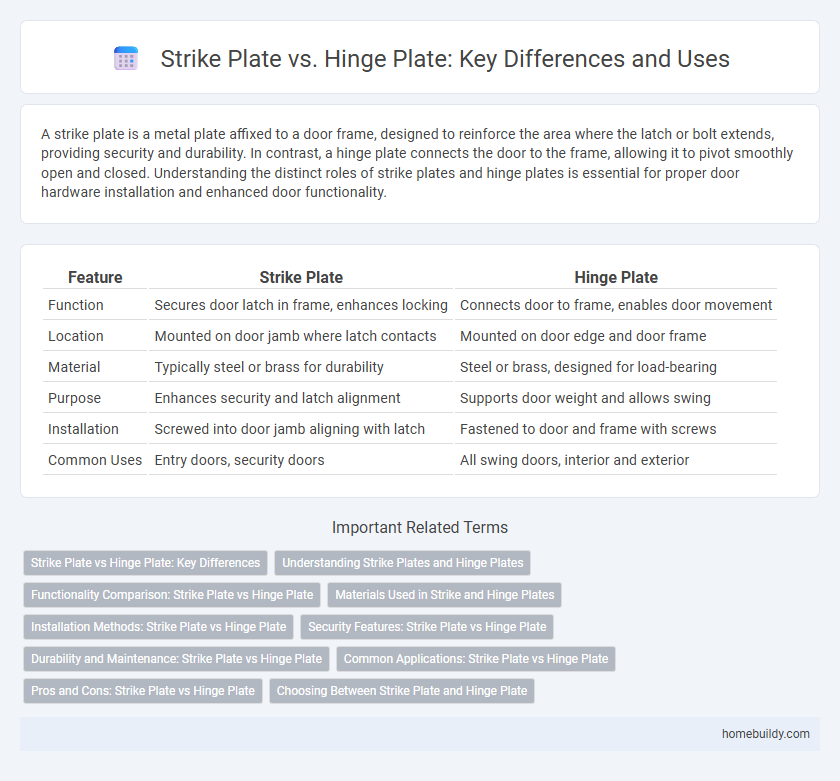A strike plate is a metal plate affixed to a door frame, designed to reinforce the area where the latch or bolt extends, providing security and durability. In contrast, a hinge plate connects the door to the frame, allowing it to pivot smoothly open and closed. Understanding the distinct roles of strike plates and hinge plates is essential for proper door hardware installation and enhanced door functionality.
Table of Comparison
| Feature | Strike Plate | Hinge Plate |
|---|---|---|
| Function | Secures door latch in frame, enhances locking | Connects door to frame, enables door movement |
| Location | Mounted on door jamb where latch contacts | Mounted on door edge and door frame |
| Material | Typically steel or brass for durability | Steel or brass, designed for load-bearing |
| Purpose | Enhances security and latch alignment | Supports door weight and allows swing |
| Installation | Screwed into door jamb aligning with latch | Fastened to door and frame with screws |
| Common Uses | Entry doors, security doors | All swing doors, interior and exterior |
Strike Plate vs Hinge Plate: Key Differences
Strike plates and hinge plates serve distinct functions in door hardware, with strike plates reinforcing the door frame where the latch or bolt secures, while hinge plates support the pivoting action of the door. Strike plates are typically installed on the door jamb to absorb impact and prevent damage from repeated latching, enhancing security, whereas hinge plates attach to both the door and frame to facilitate smooth opening and closing. Understanding these key differences helps in selecting the appropriate hardware for door installation and maintenance.
Understanding Strike Plates and Hinge Plates
Strike plates and hinge plates serve distinct functions in door hardware, with strike plates providing a reinforced surface for the door latch or bolt to secure into the door frame. Strike plates are typically installed on the door frame and are crucial for door security and proper latch alignment, while hinge plates are mounted on the door and frame to facilitate smooth pivoting motion. Understanding these differences helps ensure correct hardware selection and optimum door performance.
Functionality Comparison: Strike Plate vs Hinge Plate
The strike plate secures the door latch or bolt, ensuring proper alignment and locking functionality, while the hinge plate supports the door's pivot movement by attaching it to the frame. Strike plates are crucial for door security and resistance to forced entry, whereas hinge plates provide stability and smooth operation during opening and closing. Both components work together to maintain door integrity but serve distinctly different roles in door hardware functionality.
Materials Used in Strike and Hinge Plates
Strike plates are commonly made from durable metals such as stainless steel, brass, or reinforced zinc to withstand repeated impact and provide secure door locking. Hinge plates often utilize materials like steel or aluminum for strength and corrosion resistance while maintaining smooth door movement. The choice of materials in strike and hinge plates directly influences durability, security, and longevity of door hardware systems.
Installation Methods: Strike Plate vs Hinge Plate
Strike plate installation involves mortising the door frame to ensure the plate sits flush, securing it with screws to reinforce the latch or deadbolt. In contrast, hinge plate installation requires aligning the door hinges with the corresponding frame mortises, attaching both the door and frame sections with screws for proper door movement. Precise measurements and proper screw placement are crucial for both plates to guarantee functionality and security.
Security Features: Strike Plate vs Hinge Plate
Strike plates provide critical security by reinforcing door frames and resisting forced entry through heavy-duty metal construction and long screws anchoring into wall studs. Hinge plates, while primarily supporting door hinges, enhance security by preventing hinge pin removal and resisting door removal, especially on outward-opening doors. Compared to hinge plates, strike plates offer a more direct barrier against kick-ins and prying attacks, making them essential for high-security door installations.
Durability and Maintenance: Strike Plate vs Hinge Plate
Strike plates are typically made from hardened steel, offering superior durability and resistance to wear compared to hinge plates, which are often constructed from lighter metals or alloys. Maintenance for strike plates is minimal, focusing mainly on ensuring alignment for secure door latching, while hinge plates may require more frequent lubrication and tightening due to their moving parts. The robust design of strike plates contributes to enhanced security and longevity, reducing the need for frequent replacements compared to hinge plates.
Common Applications: Strike Plate vs Hinge Plate
Strike plates are primarily used in door locking systems to reinforce the latch or bolt area, providing secure closure in residential and commercial doors. Hinge plates, on the other hand, serve as mounting points for door hinges, enabling smooth pivoting and alignment between the door and frame, commonly found in cabinet doors and heavy gateways. Understanding the functional differences helps in selecting strike plates for enhanced security and hinge plates for structural support in various installations.
Pros and Cons: Strike Plate vs Hinge Plate
Strike plates offer superior security by reinforcing door frames against forced entry, making them essential for effective lock installation, but they can be challenging to align perfectly and may require precise mortising. Hinge plates provide stability and weight distribution for doors, ensuring smooth operation and preventing sagging, yet they do not contribute significantly to security and are vulnerable points if hinges are exposed. Choosing strike plates enhances intrusion resistance, while hinge plates primarily support door functionality, so selection depends on prioritizing security or mechanical performance.
Choosing Between Strike Plate and Hinge Plate
Choosing between a strike plate and a hinge plate depends on their distinct functions in door hardware systems. Strike plates reinforce the door frame where the latch or bolt engages, enhancing security, while hinge plates support the door's pivot point, ensuring smooth operation and alignment. Prioritizing security needs favors strike plates, whereas durability and door movement optimization call for hinge plates.
strike plate vs hinge plate Infographic

 homebuildy.com
homebuildy.com